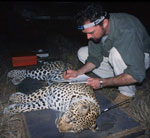Rare Indo-Chinese tiger spotted in southern China for the first time in years
Indo-Chinese tiger spotted in China for first time in years
mongabay.com
June 13, 2007
Scientists captured a wild Indo-Chinese tiger on film in a nature reserve in China’s southeastern Yunnan Province, reports the Worldwatch Institute.
The great cat was photographed in Xishuangbanna National Nature Reserve using infrared cameras. It was the first time the rare Indo-Chinese tiger (Panthera tigris corbetti) has been photographed in Yunnan.
China is home to four subspecies of tiger—the Northeast China tiger, the South China tiger, the Indo-Chinese tiger, and the Bengal tiger—all of which are limited to less than 50 individuals. Habitat destruction and hunting are the biggest threat to tigers. The Chinese government is currently lobbying delegates at the Convention on International Trade in Endangered Species of Wild Fauna and Flora meeting in The Hague to legalize the trade in tiger skins, a move that environmentalists say will doom tigers to extinction.
“A legal market in China for products made from farmed tigers will increase demand and allow criminals to launder’ products made from tigers poached from the wild,” said Eric Dinerstein, chief scientist at World Wildlife Fund (WWF) who recently authored a paper on the trade in tiger parts.
Globally, tigers now occupy just 7 percent of their historical range, according to WWF.
Related article
An interview with biologist Luke Hunter:
How to save the world’s big cats

|
(05/21/2007) Big cats are some of Earth’s largest and most threatened predators. Long persecuted as perceived threats to livestock and humans, hunted for their skins and purported medicinal values, and losing critical habitat to deforestation and conversion for agriculture, big cat populations have dwindled around the world for the past century. Given these trends, it should come as no surprise that big cats have become the focus of conservation efforts. Not only are large predators often the most vulnerable to human pressures and the first to disappear from ecosystems, but efforts to conserve them effectively help protect thousands of other species that share their habitat. At the forefront of these efforts in Dr. Luke Hunter, a biologist with the Wildlife Conservation Society (WCS) where he heads their Great Cats Program. In a May 2007 interview with mongabay.com, Hunter discussed strategies for conserving carnivores and offered insight for students interested in pursuing careers in conservation science.














